Fatigue Analysis of Spike Segment of Special Tractor Wheels in Terms of Design Improvement for Chernozem Soil
Abstract
:1. Introduction
2. Materials and Methods
2.1. Principle of Special Driving Wheels
2.2. Forces Loading the Spike Segment
- -
- tangential force FT, which acts on the spike segment from the drawbar pull generated by the tractor and
- -
- normal force FN, which acts when the spike segment penetrates the ground.
2.3. Measurement of Maximum Drawbar Pull at 100% Driving Wheels Slip
2.4. Field Conditions
2.5. Fatigue Analysis of Spike Segment
3. Results and Discussion
3.1. Drawbar Pull at 100% Wheel Slip
3.2. Boundary Conditions of the Spike Segment
3.3. Run Analysis and Results
4. Conclusions
Author Contributions
Funding
Institutional Review Board Statement
Informed Consent Statement
Data Availability Statement
Conflicts of Interest
References
- López-Vázquez, A.; Cadena-Zapata, M.; Campos-Magaña, S.; Zermeño-Gonzalez, A.; Mendez-Dorado, M. Comparison of energy used and effects on bulk density and yield by tillage systems in a semiarid condition of Mexico. Agronomy 2019, 9, 189. [Google Scholar] [CrossRef] [Green Version]
- Semetko, J.; Janoško, I.; Pernis, P. Determination of driving force of tractor and trailer wheels. Acta Technol. Agric. 2002, 5, 1–4. [Google Scholar]
- Kim, Y.-S.; Kim, W.-S.; Siddique, M.A.A.; Baek, S.-Y.; Baek, S.-M.; Cheon, S.-H.; Lee, S.-D.; Lee, K.-H.; Hong, D.-H.; Park, S.-U.; et al. Power transmission efficiency analysis of 42 kW power agricultural tractor according to tillage depth during moldboard plowing. Agronomy 2020, 10, 1263. [Google Scholar] [CrossRef]
- Raheman, H.; Jha, S.K. Wheel slip measurement in 2WD tractor. J. Terramech. 2007, 44, 89–94. [Google Scholar] [CrossRef]
- Ashok Kumar, A.; Tewari, V.K.; Nare, B. Embedded digital draft force and wheel slip indicator for tillage research. Comput. Electron. Agric. 2016, 127, 38–49. [Google Scholar] [CrossRef]
- Moitzi, G.; Wagentristl, H.; Refenner, K.; Weingartmann, H.; Piringer, G.; Boxberger, J.; Gronauer, A. Effects of working depth and wheel slip on fuel consumption of selected tillage implements. Agric. Eng. Int. CIGR E-J. 2014, 16, 182–190. [Google Scholar]
- Schreiber, M.; Kutzbach, H.D. Influence of soil and tire parameters on traction. Res. Agric. Eng. 2008, 54, 43–49. [Google Scholar] [CrossRef] [Green Version]
- Battiato, A.; Diserens, E. Tractor traction performance simulation on differently textured soils and validation: A basic study to make traction and energy requirements accessible to the practice. Soil Tillage Res. 2017, 166, 18–32. [Google Scholar] [CrossRef]
- Kim, W.S.; Kim, Y.J.; Baek, S.M.; Baek, S.Y.; Moon, S.P.; Lee, N.G.; Kim, T.J.; Siddique, A.A.; Jeon, H.H.; Kim, Y.S. Effect of the cone index on the work load of the agricultural tractor. J. Drove Control 2020, 17, 9–18. [Google Scholar]
- Moinfar, A.M.; Shahgholi, G.; Gilandeh, Y.A.; Gundoshmian, T.M. The effect of the tractor driving system on its performance and fuel consumption. Energy 2020, 202, 117803. [Google Scholar] [CrossRef]
- Semetko, J.; Janoško, I.; Pernis, P. Determination of power of multidrive vehicles. Acta Technol. Agric. 2004, 7, 20–23. [Google Scholar]
- Arvidsson, J.; Westlin, H.; Keller, T.; Gilbertsson, M. Rubber track systems for conventional tractors—Effects on soil compaction and traction. Soil Tillage Res. 2011, 117, 103–109. [Google Scholar] [CrossRef]
- Mudarisov, S.; Gainullin, I.; Gabitov, I.; Khasanov, E. Improvement of traction indicators of a track-chain tractor. Commun. Sci. Lett. Univ. Zilina 2020, 22, 89–102. [Google Scholar] [CrossRef]
- Molari, G.; Bellentani, L.; Guarnieri, A.; Walker, M.; Sedoni, E. Performance of an agricultural tractor fitted with rubber tracks. Biosyst. Eng. 2020, 111, 57–63. [Google Scholar] [CrossRef]
- Ge, J.; Wang, X.; Kito, K. Comparing tractive performance of steel and rubber single grouser shoe under different soil moisture contents. Int. J. Agric. Biol. Eng. 2016, 9, 11–20. [Google Scholar]
- Serrano, J.M.; Peça, J.O.; Marques da Silva, J.; Pinheiro, A.; Carvalho, M. Tractor energy requirements in disc harrow systems. Biosyst. Eng. 2007, 98, 286–296. [Google Scholar] [CrossRef]
- Freitag, D.R. Wheels on Soft Soils: An Analysis of Existing Data; Army MRC: Vicksburg, MI, USA, 1965. [Google Scholar]
- Grigorev, I.; Kunickaya, O.; Tikhonov, E.; Hertz, E.; Khakhina, A.; Burmistrova, O.; Sukhomlinova, N.; Zhuk, A. Methodology for assessing and managing the environmental performance of skidding and feller buncher tractors. Forests 2021, 12, 1723. [Google Scholar] [CrossRef]
- Taghavifar, H.; Mardani, A. Potential of functional image processing technique for the measurements of contact area and contact pressure of a radial ply tire in a soil bin testing facility. Measurement 2013, 46, 4038–4044. [Google Scholar] [CrossRef]
- Way, T.R.; Kishimoto, T. Interface pressures of a tractor drive tyre on structured and loose soils. Biosyst. Eng. 2004, 87, 375–386. [Google Scholar] [CrossRef]
- Kučera, M.; Helexa, M.; Molenda, M. Selected tire characteristics and their relation to its radial stiffness. MM Sci. J. 2016, 9, 1524–1530. [Google Scholar] [CrossRef]
- Janulevičius, A.; Damanauskas, V. How to select air pressures in the tires of MFWD (mechanical front-wheel drive) tractor to minimize fuel consumption for the case of reasonable wheel slip. Energy 2015, 90, 691–700. [Google Scholar] [CrossRef]
- Šmerda, T.; Čupera, J. Tire inflation and its influence on drawbar characteristics and performance—Energetic indicators of a tractor set. J. Terramech. 2010, 47, 395–400. [Google Scholar] [CrossRef]
- Battiato, A.; Diseren, E. Influence of tyre inflation pressure and wheel load on the traction performance of a 65 kW MFWD tractor on a cohesive soil. J. Agric. Sci. 2013, 5, 197–215. [Google Scholar] [CrossRef]
- Gee-Clough, D.; McAllister, R.M.; Evernden, D.W. Tractive performance of tractor drive tyres. J. Agric. Eng. Res. 1977, 22, 385–395. [Google Scholar] [CrossRef]
- Helexa, M. Monitoring the impact of tyre inflation pressure on tensile properties of forest tractor. Res. Agric. Eng. 2014, 60, 127–133. [Google Scholar] [CrossRef] [Green Version]
- Forster, M.; Ugarte, C.; Lamandé, M.; Faucon, M.P. Relationships between root traits and soil physical properties after field traffic from the perspective of soil compaction mitigation. Agronomy 2020, 10, 1697. [Google Scholar] [CrossRef]
- Malý, V.; Kučera, M. Determination of mechanical properties of soil under laboratory conditions. Res. Agric. Eng. 2014, 60, 66–69. [Google Scholar] [CrossRef] [Green Version]
- Malý, V.; Tóth, F.; Mareček, J.; Krčálová, E. Laboratory test of the soil compaction. Acta Univ. Agric. Et Silvic. Mendel. Brun. 2015, 63, 77–85. [Google Scholar] [CrossRef] [Green Version]
- Zhang, Y.; Zhang, L.; Wand, W.; Li, Y.; Zhang, Q. Design and implementation of a two-wheel and hopping robot with a linkage mechanism. IEEE Access 2018, 6, 42422–42429. [Google Scholar] [CrossRef]
- Ding, L.; Gao, H.; Deng, Z.; Nagatani, K.; Yoshida, K. Experimental study and analysis on driving wheels’ performance for planetary exploration rovers moving in deformable soil. J. Terramech. 2011, 48, 27–45. [Google Scholar] [CrossRef]
- Wang, X.L.; Yamazaki, M.; Tanaka, T. Characteristics of soil reactions of an open lugged wheel under paddy soil conditions. J. Terramech. 1995, 32, 115–125. [Google Scholar] [CrossRef]
- Salokhe, V.M.; Manzoor, S.; Gee-Clough, D. The measurement of forces on a cage wheel lug when operating in wet clay soil. Soil Tillage Res. 1989, 14, 327–340. [Google Scholar] [CrossRef]
- Md-Tahir, H.; Zhang, J.; Xia, J.; Zhou, Y.; Zhou, H.; Du, J.; Sultan, M.; Mamona, H. Experimental investigation of traction power transfer indices of farm-tractors for efficient energy utilization in soil tillage and cultivation operations. Agronomy 2021, 11, 168. [Google Scholar] [CrossRef]
- Gasparetto, E.; Febo, P.; Pessina, D.; Rizzato, E. The rolling resistance of narrow steel wheels in Italian paddy fields. J. Agric. Eng. Res. 1992, 52, 91–100. [Google Scholar] [CrossRef]
- Hendriadi, A.; Salokhe, V.M. Improvement of a power tiller cage wheel for use in swampy peat soils. J. Terramech. 2002, 39, 55–70. [Google Scholar] [CrossRef]
- Fajardo, A.L.; Suministrado, D.C.; Peralta, E.K.; Bato, P.M.; Paningbatan, E.P. Force and puddling characteristics of the tilling wheel of float-assisted tillers at different lug angle and shaft speed. Soil Tillage Res. 2014, 140, 118–125. [Google Scholar] [CrossRef]
- Nakanishi, R.; Nakashima, H.; Miyasaka, J.; Ohdoi, K. Tractive performance analysis of a lugged wheel by open-source 3D DEM software. J. Terrramech. 2020, 92, 51–65. [Google Scholar] [CrossRef]
- Watyotha, C.; Salokhe, V.M. PM—Power and machinery: Tractive performance of cage wheels with opposing circumferential lugs. J. Agric. Eng. Res. 2001, 79, 389–398. [Google Scholar] [CrossRef]
- Triratanasirichai, K.T.; Oida, A.; Honda, M. The performance of cage wheels for small power tillers in agricultural soil. J. Terramech. 1990, 27, 193–205. [Google Scholar] [CrossRef]
- Hermawan, W.; Yamazaki, M.; Oida, A. Experimental analysis of soil reaction on a lug of a movable lug wheel. J. Terramech. 1998, 35, 119–135. [Google Scholar] [CrossRef]
- Yang, Y.; Yi, S.; Shugen, M. Drawbar pull of a wheel with an actively actuated lug on sandy terrain. J. Terramech. 2014, 56, 17–24. [Google Scholar] [CrossRef]
- Wilson, C.A.; Kushwaha, R.L.; Mehta, A.V. Performance of Dyna-bite traction system. SAE Trans. 1993, 102, 265–271. Available online: http://www.jstor.org/stable/44722932 (accessed on 11 October 2021).
- Walker, J.T. Dyna-bite tractor tire attachment performance in clay soil. Trans. ASAE 1986, 29, 1213–1217. [Google Scholar] [CrossRef]
- Traction Enhancing Device Including Flexible Frame Means for Agricultural Wheeled Tractors and the Like. U.S. 5,242,214; United States Patent and Trademark Office: Alexandria, VA, USA, 1993; Available online: https://patents.google.com/patent/US5242214A/enhttps://www.farmshow.com/a_article.php?aid=9483 (accessed on 11 October 2021).
- Kumar, A.; Grover, K.; Budania, B. Optimization of Connecting Rod Parameters Using CAE Tools. Int. J. Latest Trends Eng. Technol. 2012, 3, 1–7. Available online: https://www.ijltet.org/wp-content/uploads/2012/10/15.pdf (accessed on 11 June 2021).
- Ghodake, M. Weight optimalization of alloy wheel. Int. J. Eng. Technol. 2017, 4, 547–553. Available online: https://www.irjet.net/archives/V4/i9/IRJET-V4I993.pdf (accessed on 18 June 2021).
- Majdan, R.; Abrahám, R.; Tkáč, Z.; Mojžiš, M. Drawbar parameters of tractor with prototypes of driving wheels and standard tyres. Acta Technol. Agric. 2018, 21, 63–68. [Google Scholar] [CrossRef] [Green Version]
- Abrahám, R.; Majdan, R.; Drlička, R. Special tractor driving wheels with two modification of spikes inclination angle. Agron. Res. 2019, 17, 333–342. [Google Scholar]
- Abrahám, R.; Varga, F.; Majdan, R.; Mojžiš, M. Design of improvement of adhesive properties of tyres on snow, ice and soil. Acta Technol. Agric. 2012, 15, 1–4. [Google Scholar]
- STN ISO 789-9; Power Test for Drawbar. Slovak Office of Standards. Metrology and Testing: Bratislava, Slovakia, 1993.
- Rasool, S.; Raheman, H. Improving the tractive performance of walking tractors using rubber tracks. Biosyst. Eng. 2018, 167, 51–62. [Google Scholar] [CrossRef]
- Varani, M.; Mattetti, M.; Maraldi, M.; Molari, G. Mechanical devices for mass distribution adjustment: Are they really convenient? Agronomy 2020, 10, 1820. [Google Scholar] [CrossRef]
- Rasool, S.; Raheman, H.; Upadhyay, G. Development of an instrumentation system for evaluating the tractive performance of walking tractors. Int. J. Curr. Microbiol. Appl. Sci. 2017, 6, 759–770. [Google Scholar] [CrossRef]
- Majdan, R.; Abrahám, R.; Tkáč, Z.; Drlička, R.; Matejková, E.; Kollárová, K.; Mareček, J. Static lateral stability of tractor with rear wheel ballast weights: Comparison of ISO 16231-2 (2015) with experimental data regarding tyre deformation. Appl. Sci. 2021, 11, 381. [Google Scholar] [CrossRef]
- Badules, J.; Vidal, M.; Boné, A.; Gil, E.; García-Ramos, F.J. CFD models as a tool to analyze the performance of the hydraulic agitation system of an air-assisted sprayer. Agronomy 2019, 9, 769. [Google Scholar] [CrossRef] [Green Version]
- Upadhyay, G.; Raheman, H.; Rasool, S. Three dimensional modelling and stress analysis of a powered single acting disc harrow using FEA. Curr. Agric. Res. J. 2017, 5, 203–219. [Google Scholar]
- Fernández, R.E.H.; Carranza-Cañadas, P.; García-Salcedo, F.J.; Triviño-Tarradas, P. Parameterisation and optimisation of a hand-rake sweeper: Application in olive picking. Agriculture 2020, 10, 379. [Google Scholar] [CrossRef]
- Bader, Q.; Kadum, E. Mean stress correction effects on the fatigue life behavior of steel alloys by using stress life approach theories. Int. J. Eng. Technol. 2014, 14, 50–58. [Google Scholar]
- de Jesus, A.M.P.; Matos, R.; Fontoura, B.F.C.; Rebelo, C.; da Silva, L.S.; Veljkovic, M. A comparison of the fatigue behavior between S355 and S690 steel grades. J. Constr. Steel Res. 2012, 79, 140–150. [Google Scholar] [CrossRef]
- Watyotha, C.; Gee-Clough, D.; Salokhe, V.M. Effect of circumferential angle, lug spacing and slip on lug wheel forces. J. Terramech. 2001, 38, 1–14. [Google Scholar] [CrossRef]
- Irani, R.A.; Bauer, R.J.; Warkentin, A. A dynamic terramechanic model for small lightweight vehicles with rigid wheels and grousers operating in sandy soil. J. Terramech. 2011, 48, 307–318. [Google Scholar] [CrossRef]
- Ozaki, S.; Hinata, K.; Senatore, C.; Iagnemma, K. Finite element analysis of periodic ripple formation under rigid wheels. J. Terramech. 2015, 61, 11–22. [Google Scholar] [CrossRef]
- Abrahám, R.; Majdan, R.; Kollárová, K.; Tkáč, Z.; Olejár, M.; Matejková, E.; Kubík, Ľ. Frequency spectra analysis of drawbar pulls generated by special driving wheels improving tractive performance. Sensors 2021, 21, 2903. [Google Scholar] [CrossRef] [PubMed]
- Henriques, B.; Carvalho, M.; Tavares, S.M.O.; de Castro, P.M.S.T. A comparison of safety factor values for Soderberg and DIN 743 fatigue analyses. U. Porto J. Eng. 2021, 7, 11–21. [Google Scholar] [CrossRef]
- DIN 743; Calculation of Load Capacity of Shafts and Axles. German Institute for Standardization: Berlin, Germany, 2012.


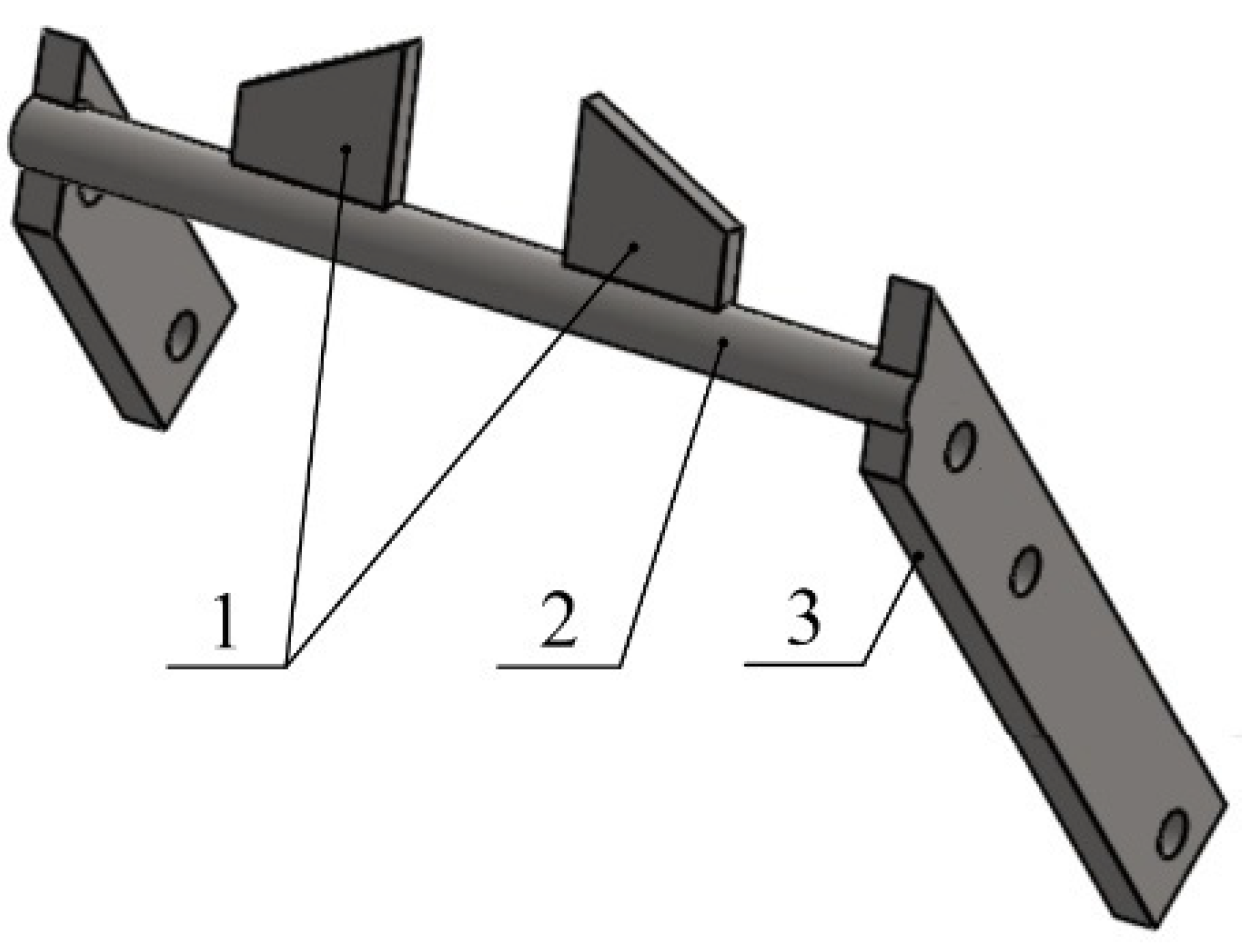
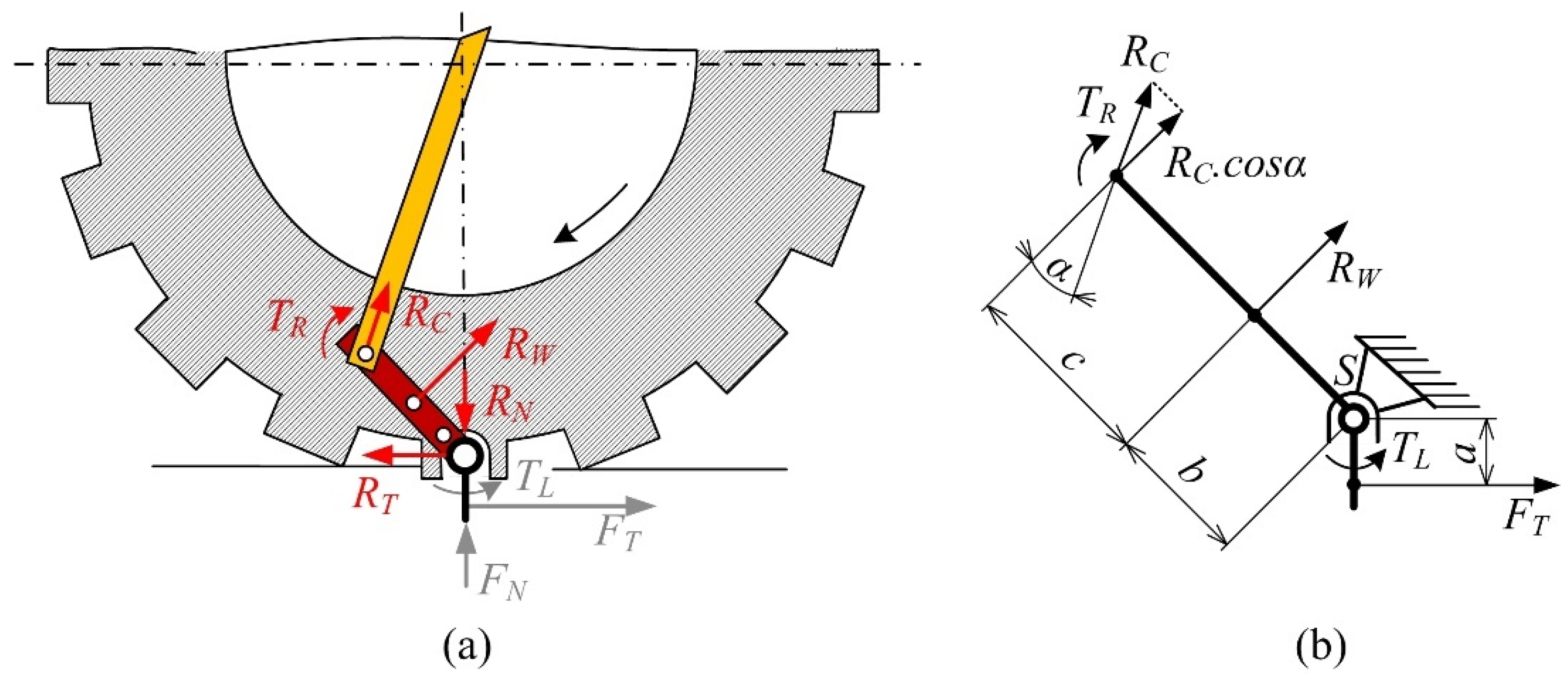

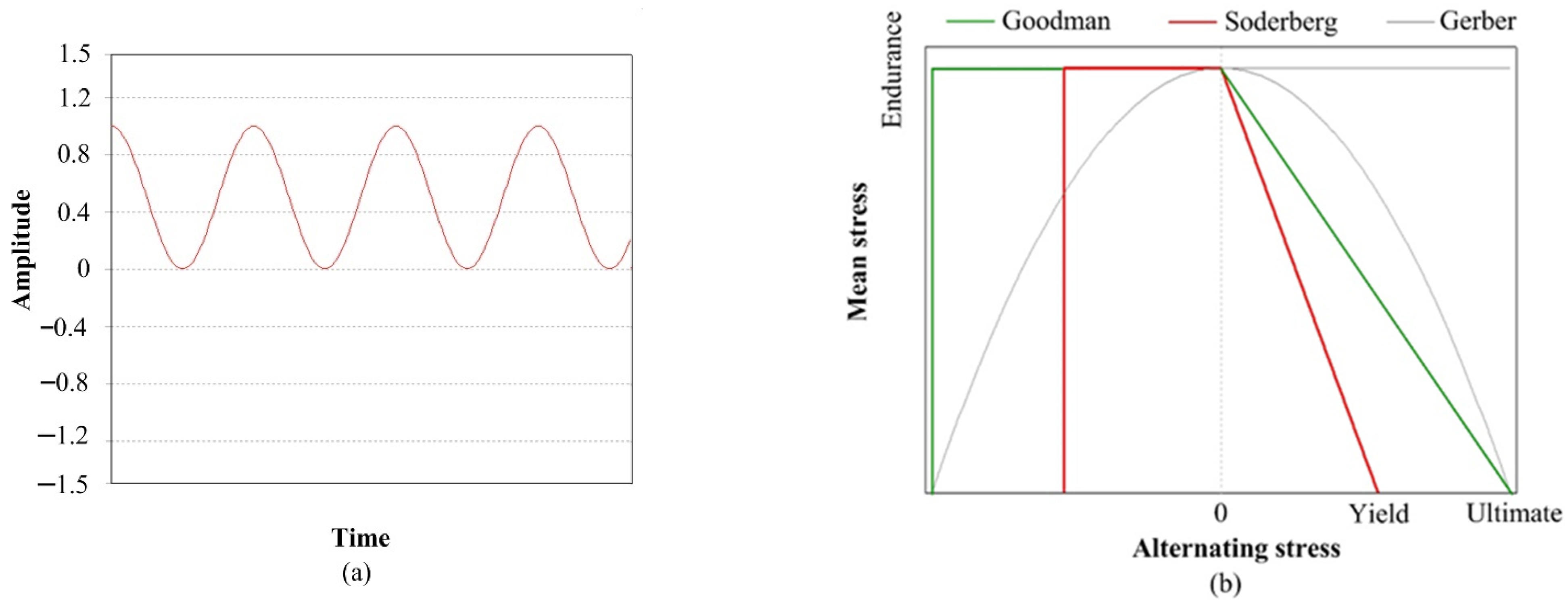
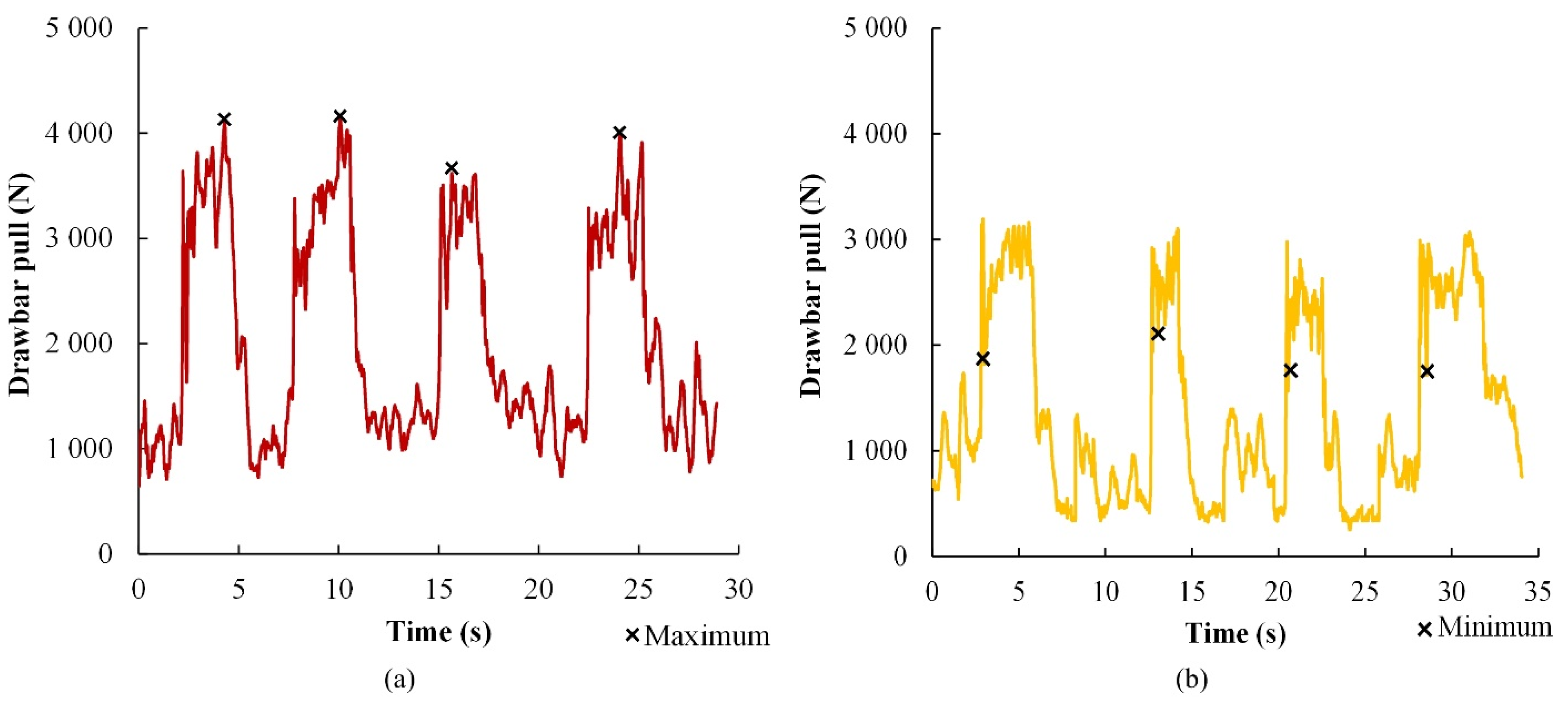

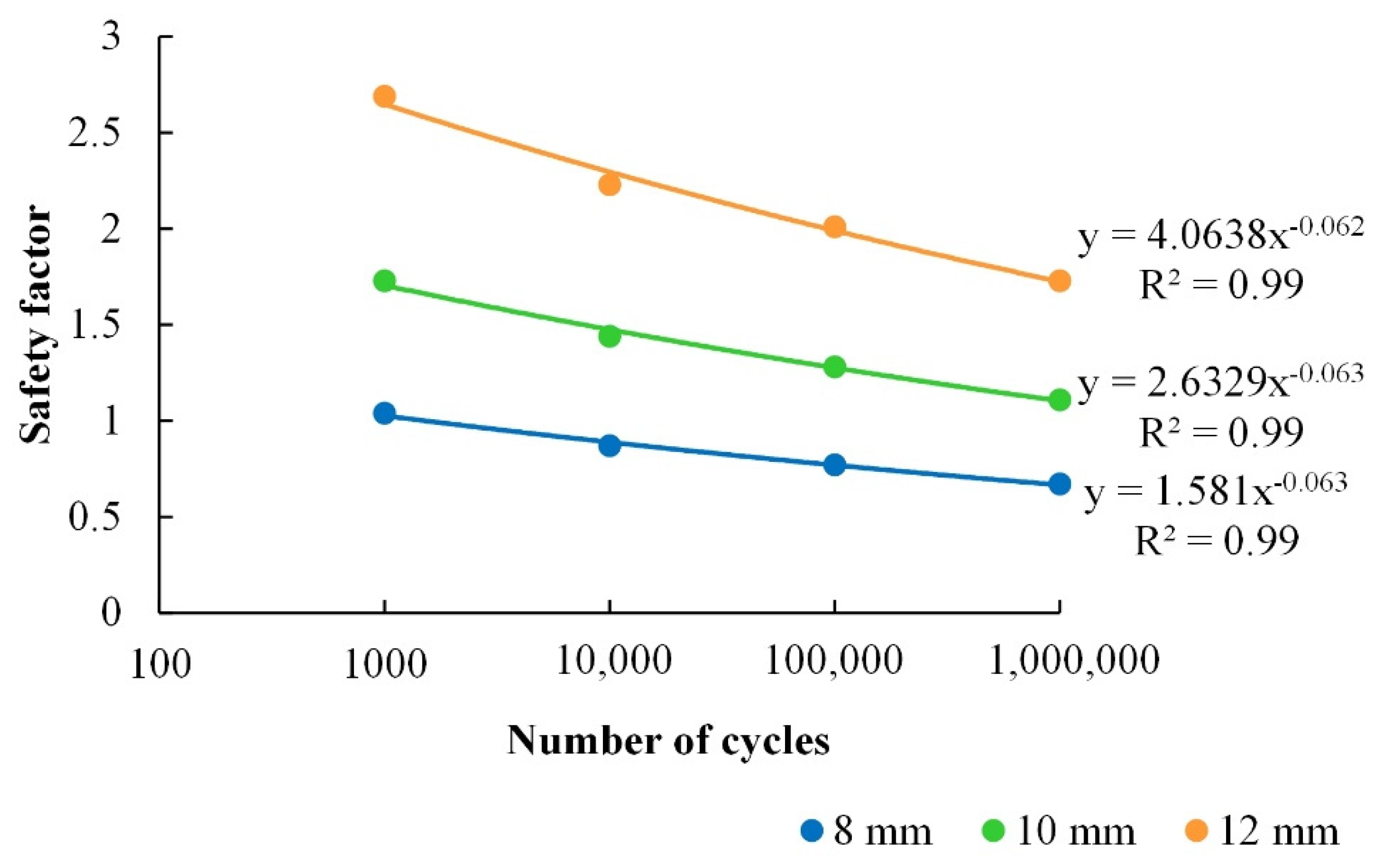
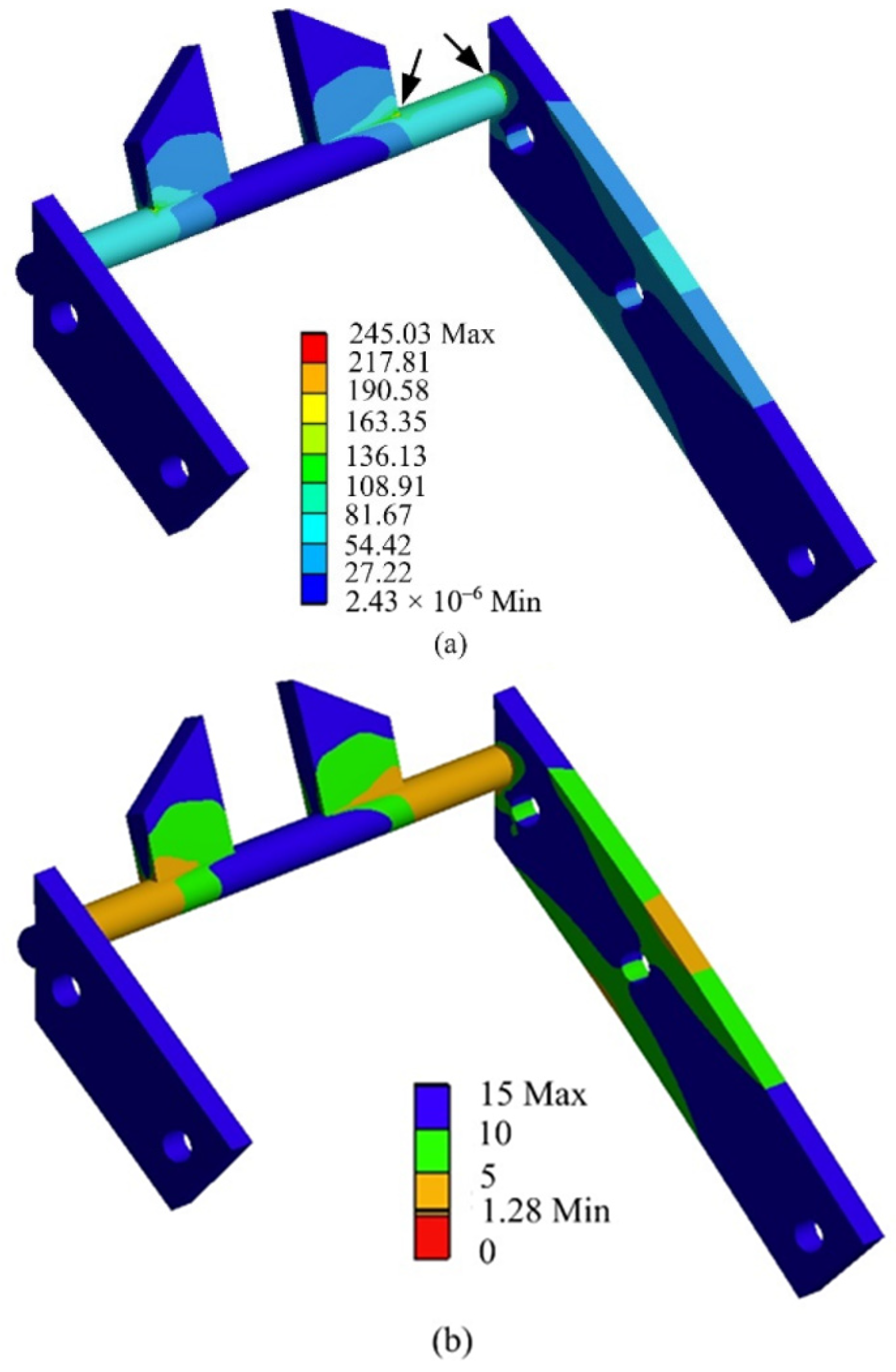
| Parameter | Unit | Value |
|---|---|---|
| soil order | Chernozem | |
| soil texture | loamy sand | |
| gravel | % | 15.3 |
| sand | % | 45.2 |
| silt | % | 35.4 |
| clay | % | 4.1 |
| organic matter | % | 6.62 |
| frictional angle | ° | 47.5 |
| cohesion | kPa | 8.4 |
| particle density | g·cm−3 | 2.6 |
| moisture content (dry basis) | % | 18.8 |
| Depth (cm) | ||||||||||
|---|---|---|---|---|---|---|---|---|---|---|
| 4 | 8 | 12 | 16 | 20 | 24 | 28 | 32 | 36 | 40 | |
| measurement 1 | 0.22 | 0.65 | 0.80 | 1.01 | 1.22 | 1.24 | 1.39 | 1.45 | 1.69 | 1.78 |
| measurement 2 | 0.32 | 0.86 | 0.90 | 1.18 | 1.24 | 1.33 | 1.42 | 1.54 | 1.65 | 1.93 |
| measurement 3 | 0.39 | 0.72 | 1.10 | 1.20 | 1.38 | 1.39 | 1.56 | 1.60 | 1.83 | 2.11 |
| average | 0.31 | 0.74 | 0.93 | 1.13 | 1.28 | 1.32 | 1.46 | 1.53 | 1.72 | 1.94 |
| standard deviation | 0.09 | 0.11 | 0.15 | 0.12 | 0.09 | 0.08 | 0.09 | 0.08 | 0.09 | 0.17 |
| Material | Young′s Modulus | Poisson′s Ratio | Tensile Yield Strength | Ultimate Tensile Strength |
|---|---|---|---|---|
| (GPa) | (MPa) | (MPa) | ||
| S355 | 210 | 0.3 | 355 | 470 |
| Wheel Type | Gear | Level | Number of Measurements | |||
|---|---|---|---|---|---|---|
| 1 | 2 | 3 | 4 | |||
| Standard tires | 1st | Minimum | 1966 | 2134 | 1856 | 1893 |
| Spike tires | Maximum | 4079 | 4136 | 3617 | 3979 | |
| Connection Rod Diameter (mm) | Number of Cycles | |||
|---|---|---|---|---|
| 1000 | 10,000 | 100,000 | 1,000,000 | |
| 8 | 1.04 | 0.87 | 0.77 | 0.67 |
| 10 | 1.73 | 1.44 | 1.28 | 1.11 |
| 12 | 2.69 | 2.23 | 2.01 | 1.73 |
Publisher’s Note: MDPI stays neutral with regard to jurisdictional claims in published maps and institutional affiliations. |
© 2022 by the authors. Licensee MDPI, Basel, Switzerland. This article is an open access article distributed under the terms and conditions of the Creative Commons Attribution (CC BY) license (https://creativecommons.org/licenses/by/4.0/).
Share and Cite
Abrahám, R.; Majdan, R.; Kollárová, K.; Tkáč, Z.; Hajdu, Š.; Kubík, Ľ.; Masarovičová, S. Fatigue Analysis of Spike Segment of Special Tractor Wheels in Terms of Design Improvement for Chernozem Soil. Agriculture 2022, 12, 471. https://doi.org/10.3390/agriculture12040471
Abrahám R, Majdan R, Kollárová K, Tkáč Z, Hajdu Š, Kubík Ľ, Masarovičová S. Fatigue Analysis of Spike Segment of Special Tractor Wheels in Terms of Design Improvement for Chernozem Soil. Agriculture. 2022; 12(4):471. https://doi.org/10.3390/agriculture12040471
Chicago/Turabian StyleAbrahám, Rudolf, Radoslav Majdan, Katarína Kollárová, Zdenko Tkáč, Štefan Hajdu, Ľubomír Kubík, and Soňa Masarovičová. 2022. "Fatigue Analysis of Spike Segment of Special Tractor Wheels in Terms of Design Improvement for Chernozem Soil" Agriculture 12, no. 4: 471. https://doi.org/10.3390/agriculture12040471
APA StyleAbrahám, R., Majdan, R., Kollárová, K., Tkáč, Z., Hajdu, Š., Kubík, Ľ., & Masarovičová, S. (2022). Fatigue Analysis of Spike Segment of Special Tractor Wheels in Terms of Design Improvement for Chernozem Soil. Agriculture, 12(4), 471. https://doi.org/10.3390/agriculture12040471






